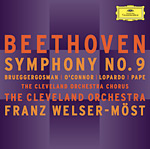Franz Welser-Möst’s new Beethoven Ninth, his first recording for Deutsche Grammophon, oddly sounds as if it had been made 20 years ago, so unaware is it of any of the subsequent advances in Beethoven scholarship/performance practice. So, instead of the incisive and crisply articulated Allegro and Molto vivace movements of the recent Vänskä and Haitink readings, we get the blended sonorities and smoothed-out rhythms of Karajan’s last recordings. But at least Karajan always generated tension in the Ninth; with Welser-Möst there’s just no grit to the playing, a fatal flaw that makes this performance quite bland. The recording may be partly to blame: with timpani that sound like fur mallets hitting on a barrel, the first-movement climax is frustratingly tepid, as are similar moments in the scherzo.
The performance improves somewhat in the symphony’s second half, where Welser-Möst’s flowing tempo and tender phrasing make the third movement sound more like a serenade than the usual prayer. And while the recording makes hash out of the antiphonal writing in the finale’s introduction, things pick up noticeably with the arrival of René Pape’s warm-toned and well-projected bass solo. The other soloists do quite well, including the helden-tenorish Frank Lopardo and the radiant Measha Brueggergosman, while the Cleveland Orchestra Chorus sounds pleasingly robust. To his credit, Welser-M_x000F_öst scrupulously avoids heaviness in this movement, even in the usually ponderous “Seid umschlungen” section, and he ends the performance in bright colors and high spirits. The problem is, to get to this point you have to endure the drab first and second movements, and quite frankly, it’s not really necessary as the Cleveland Orchestra already has fine recordings available: on Telarc with Dohnanyi, and of course the classic Szell on Sony.
































